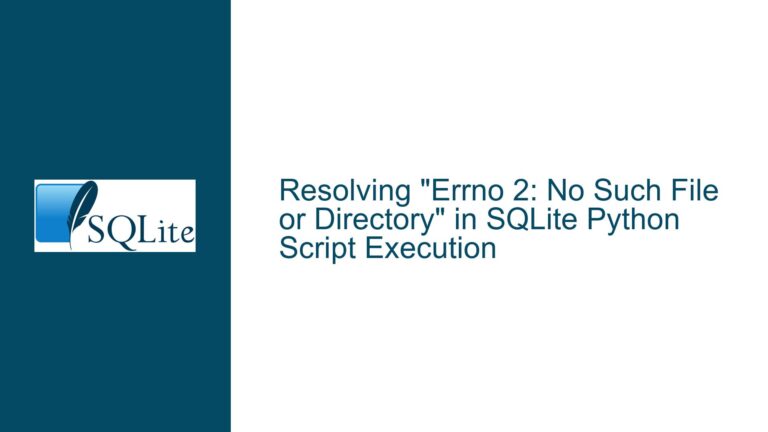Escaping Characters in SQLite3 to Prevent SQL Injection: Best Practices
SQL Injection Vulnerabilities in SQLite3 and the Role of Character Escaping
SQL injection attacks occur when untrusted user input is improperly embedded into SQL statements, allowing attackers to manipulate query logic. In SQLite3, this risk is exacerbated when raw user input is concatenated into SQL strings without proper sanitization. A common misconception is that escaping specific characters—such as single quotes (')—is sufficient to prevent these attacks. While escaping can mitigate some risks, it is not a comprehensive solution.
SQLite3 uses single quotes (') to denote string literals. If user input contains unescaped single quotes, it can prematurely terminate the string and allow injection of malicious code. For example, an input like ' OR 1=1; -- could alter query logic if not properly escaped. Escaping single quotes by doubling them (e.g., '') prevents this specific attack vector. However, other characters, such as double quotes ("), serve different purposes in SQLite3. Double quotes are used to delimit identifiers (e.g., table or column names), not string literals. Escaping them by doubling (e.g., "") is necessary only when identifiers contain reserved keywords or special characters.
The confusion arises when developers conflate escaping rules across database engines. For instance, MySQL requires backslashes (\) to escape certain characters, whereas SQLite3 does not. This inconsistency underscores the danger of relying on manual escaping as a universal defense. Furthermore, non-string data types (e.g., integers, BLOBs) introduce additional complexities. Numeric values do not require quoting, but improper validation can still lead to injection if attackers bypass type checks.
Pitfalls of Manual Escaping and Misconfigured Query Assembly
1. Over-Reliance on Single-Quote Escaping
Doubling single quotes addresses only one facet of SQL injection. Attackers can exploit other syntax elements, such as unescaped semicolons (;), comments (--), or percent signs (%) in LIKE clauses. For example, a LIKE query with user-supplied input containing % could return unintended results unless explicitly escaped using the ESCAPE clause.
2. Mixing Data and Code
SQL injection fundamentally stems from treating user input as executable code. Manual escaping attempts to "clean" the input but fails to separate data from code structurally. This approach is error-prone because:
- Developers might forget to escape inputs in all contexts.
- Escaping rules vary by context (e.g., string literals vs. identifiers).
- Multi-byte or Unicode characters can bypass simple escaping mechanisms.
3. Inadequate Handling of Non-String Data
Even if strings are properly escaped, numeric or BLOB inputs pose risks if not validated. For example, an attacker might submit a string "123; DROP TABLE users;" where a number is expected. Without strict type validation, this input could be misinterpreted as valid SQL code.
4. Complexities in Dynamic Query Generation
Applications that dynamically construct SQL queries based on user input (e.g., search filters) often resort to string concatenation. This practice increases the attack surface, as each concatenated fragment must be individually sanitized.
Secure Practices for Preventing SQL Injection in SQLite3
1. Use Prepared Statements with Parameter Binding
Prepared statements decouple SQL code from data by using placeholders (e.g., ?, :name) for user input. The SQLite3 engine compiles the query structure first, ensuring that bound parameters are treated strictly as data.
Example in Python (sqlite3 module):
conn = sqlite3.connect('mydb.sqlite')
cursor = conn.cursor()
user_input = "O'Reilly"
cursor.execute("SELECT * FROM users WHERE name = ?", (user_input,))
Here, the single quote in O'Reilly is automatically escaped by the driver.
Example in C (SQLite3 C API):
sqlite3_stmt *stmt;
const char *sql = "INSERT INTO books (title) VALUES (?);";
sqlite3_prepare_v2(db, sql, -1, &stmt, NULL);
sqlite3_bind_text(stmt, 1, user_input, -1, SQLITE_TRANSIENT);
sqlite3_step(stmt);
2. Leverage SQLite3’s printf Extensions for Dynamic Queries
When prepared statements are impractical (e.g., dynamically generated schema names), use SQLite3’s %q, %Q, and %w format specifiers in sqlite3_mprintf(). These automatically escape special characters:
%q: Escapes single quotes and surrounds the string in single quotes.%Q: Similar to%q, but returnsNULLif the input isNULL.%w: Escapes identifier names (e.g., table names) using double quotes.
Example:
char *safe_sql = sqlite3_mprintf("SELECT * FROM %w WHERE name = %q", "users", "Alice; DROP TABLE users;");
// Result: SELECT * FROM "users" WHERE name = 'Alice; DROP TABLE users;'
3. Validate and Sanitize Inputs Before Processing
- Type Checking: Ensure numeric inputs are validated as integers or floats.
- Whitelisting: Restrict string inputs to allowed characters (e.g., alphanumerics for usernames).
- Pattern Matching: Use regular expressions to reject inputs containing suspicious syntax (e.g.,
;,--).
4. Escape Special Characters in LIKE Clauses
When using LIKE with user input, escape wildcard characters (%, _) using the ESCAPE clause:
SELECT * FROM products WHERE name LIKE '%' || ? || '%' ESCAPE '\';
In this case, prepend a backslash to % or _ in the user input.
5. Avoid Dynamic Identifier Construction
If schema or column names must be dynamic, use the sqlite3_quote_name() function (C API) or the %w format specifier to safely escape identifiers.
6. Audit and Test All Query Execution Paths
- Static Analysis Tools: Use tools like CodeQL or Semgrep to detect insecure string concatenation.
- Penetration Testing: Simulate SQL injection attacks using tools like SQLMap.
- Input Fuzzing: Test edge cases with inputs containing special characters, excessively long strings, or unexpected data types.
7. Educate Developers on Secure Coding Practices
- Code Reviews: Enforce mandatory reviews for all SQL query construction.
- Documentation: Maintain internal guidelines on using prepared statements and SQLite3’s escaping functions.
By adopting these practices, developers can eliminate SQL injection vulnerabilities without relying on error-prone manual escaping. Prepared statements and parameter binding remain the gold standard, while SQLite3’s built-in escaping functions provide a robust fallback for edge cases.






